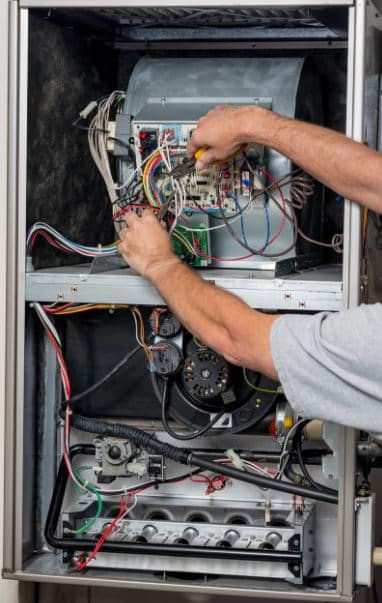
Ensuring the longevity and efficiency of your heating system begins with regular furnace maintenance. Neglecting this essential task can lead to decreased efficiency, higher energy costs, and even system failures. This comprehensive guide, tailored for Weather Masters Of Georgia, will delve into the essentials of furnace inspections, cleaning, and maintenance plans, equipping homeowners with the knowledge to keep their furnace running smoothly throughout the colder months.
Understanding Your Furnace – Basic Furnace Operation
A furnace is at the heart of a home’s heating system, working tirelessly to keep the indoor environment comfortable. Understanding its basic operation is key to recognizing when maintenance is needed.
A typical furnace ignites fuel or uses electricity to generate heat, which is then distributed throughout the home via ductwork. This process involves several components, each playing a vital role in efficient operation.
Types of Furnaces and Their Maintenance Needs
- Gas Furnaces: Require checks on burners, heat exchangers, and ventilation to prevent carbon monoxide leaks.
- Electric Furnaces: Need inspections of heating elements and electrical connections.
- Oil Furnaces: Demand frequent filter changes and burner inspections.
Step 1 – Furnace Inspection: The First Step in Furnace Maintenance
What Does a Professional Inspection Entail?
A professional inspection is a thorough examination of your furnace’s components to ensure they are in optimal condition. Technicians check for wear and tear, ensure the thermostat is functioning correctly, inspect electrical connections, and verify that the heat exchanger is intact and free of cracks.
How Often Should You Get Your Furnace Inspected?
It is recommended to have your furnace inspected at least once a year, preferably before the heating season begins. This proactive approach can identify potential issues before they become major problems.
DIY Inspection Tips
- Listen for Unusual Noises: Indicative of potential issues.
- Check the Thermostat: Ensure it’s operational.
- Regular Filter Replacement: A simple yet crucial task to maintain airflow and efficiency.
Step 2 – Furnace Cleaning: Keeping Your Furnace in Top Shape
Components That Need Regular Cleaning
Key components that require regular cleaning include the blower, the heat exchanger, and the furnace filter. A clean system runs more efficiently and has a lower risk of breakdown.
Step-by-Step Guide to Cleaning Your Furnace
- Power Off: Always turn off the power before beginning.
- Interior Vacuuming: Use a vacuum to clean the interior surfaces.
- Flame Sensor and Blower Blades: Gently clean with appropriate tools.
Safety Tips for DIY Furnace Cleaning
- Power Shutdown: Ensure the furnace is completely powered down.
- Protective Gear: Wear gloves and masks to avoid inhaling dust.
- Professional Components: Leave the heat exchanger and other complex parts to professionals.
Step 3 – Maintenance: Beyond the Basics
Common Maintenance Tasks for Furnace Longevity
Regular maintenance tasks include lubricating moving parts, checking belt tension, and ensuring the condensate drain is clear. These simple actions can significantly extend the life of your furnace.
When to Schedule Professional Maintenance
Professional maintenance should be scheduled annually. However, if you notice any signs of malfunction, such as strange noises or a yellow burner flame, schedule a service immediately.
Seasonal Maintenance Checklist
- Air Filter Replacement: At least every three months.
- Thermostat Inspection: Verify accuracy and responsiveness.
- Safety Controls Testing: Ensure they are functioning correctly.
Step 4 – Maintenance Plans: Investing in Longevity
Benefits of Having a Furnace Maintenance Plan
A maintenance plan typically includes regular inspections, priority service, and discounts on repairs. These plans can provide peace of mind and save money in the long run by preventing costly breakdowns.
What to Look for in a Maintenance Plan
When choosing a maintenance plan, look for one that offers comprehensive coverage, transparent pricing, and reliable customer support. Ensure it covers all the essential services your furnace requires.
How to Choose the Right Service Provider
Select a service provider with certified technicians, a good reputation, and a track record of quality service. Read reviews and ask for recommendations to find a trustworthy professional.
Step 5 – Troubleshooting Common Issues
Identifying and Resolving Frequent Furnace Problems
- Thermostat Issues: Often a simple battery replacement can fix issues.
- Dirty Air Filter: A common cause of reduced efficiency.
- Ignition Problems: May require professional servicing.
When to Call a Professional
If troubleshooting doesn’t resolve the issue, or if you’re unsure about performing a repair, it’s time to call a professional. It’s better to be safe than sorry when it comes to furnace repairs.
For expert furnace maintenance, trust Weather Masters Of Georgia to keep your home cozy and efficient all year round. Regular maintenance is the key to a reliable and efficient furnace. By following the guidelines outlined in this article, you can ensure your furnace remains in good working order, providing warmth and comfort for years to come.

